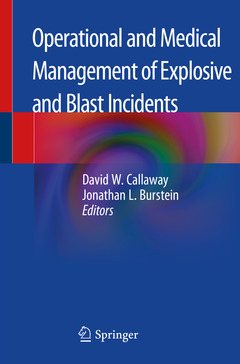Part I. Introduction
Chapter 1. Scope and Scale of the Problem
Chapter 2. Blast Physics and Biophysics
Chapter 3. State of the Science – Blast Injury Pathophysiology
Chapter 4. Operational Considerations: Review of Contemporary Data
Chapter 5. Civilian Hospital and Healthcare System Preparedness (Location, Preparedness,
Epidemiology Review of Data)
Chapter 6. Military Trauma System Response to Blast MCI
Chapter 7. The Modern Explosive Threat: Improvised Explosive Devices
Chapter 8. Interagency Collaboration and Maturation – The United Kingdom Experience
Chapter 9. Case Study: The Madrid Train Bombing of March 11, 2004
Part II. Prehospital Management
Chapter 10. Scope of the Problem and Operational Considerations
Chapter 11. Lessons in Prehospital Trauma Management During Combat
Chapter 12. First Responders: Clinical Care of Blast Trauma in the Prehospital Setting
Chapter 13. The Explosive Mass Casualty: Prehospital Incident Management and Triage
Chapter 14. Transporting Blast-Injured Patients
Chapter 15. Risk-Related Zones of Prehospital Operations
Chapter 16. Tactical Emergency Medical Support (TEMS)
Chapter 17. Case Study: Ptimary Blast Injury in a Field Setting
Chapter 18. Case Study: 2013 Boston Marathon
Part III. Emergency Department
Chapter 19. Emergency Department Response to Explosive Incidents: Scope of the Problem and
Operational Considerations
Chapter 20. Emergency Medicine: Combat Lessons Learned
Chapter 21. First Receivers: Managing Blast Injuries upon Hospital Arrival
Chapter 22. The Role of Blood Products in Damage Control Resuscitation in Explosion-Related Trauma
Chapter 23. Pediatric Considerations
Chapter 24. Organization, Operations, Management, and Their Role in Surge Capacity and Mass Casualty Incidents
Chapter 25. Case Study: Emergency Department Response to the Boston Marathon Bombing
Chapter 26. Case Study: Management of Blast Incidents in Israel
Part IV. Surgical Management
Chapter 27. Scope of the Problem and Operational Considerations: Logistics, Surge Capacity, Organizing a Response, Sustainment Issues, Resource Utilization
Chapter 28. Combat Lessons Learned
Chapter 29. Damage Control Surgery
Chapter 30. Anesthesia Care in Blast Injury
Chapter 31. Vascular Injuries
Chapter 32. Management of Thoracoabdominal Blast Injuries
Chapter 33. Genitourinary Injuries
Chapter 34. Management of Orthopaedic Blast Injuries
Chapter 35. Reconstructive Plastic Surgery in Blast and Burn Injuries
Chapter 36. Pediatric Blast Injuries
Chapter 37. Case Study: Boston Bombings, a Surgeon’s View
Part V. ICU Management
Chapter 38. ICU Management of Blast Victims: Scope of the Problem and Operational
Considerations
Chapter 39. Ventilator Strategies
Chapter 40. ICU Management: Extended Resuscitation Considerations
Chapter 41. Case Study from Afghanistan: Dismounted Complex Blast Injury
Part VI. Special Considerations
Chapter 42. Chemical, Biological, Radiological, or Nuclear Event (CBRNE): Prehospital and
Hospital Management
Chapter 43. Burn Management
Chapter 44. Wound Management
Chapter 45. Psychological Consequences: Responders and Community





